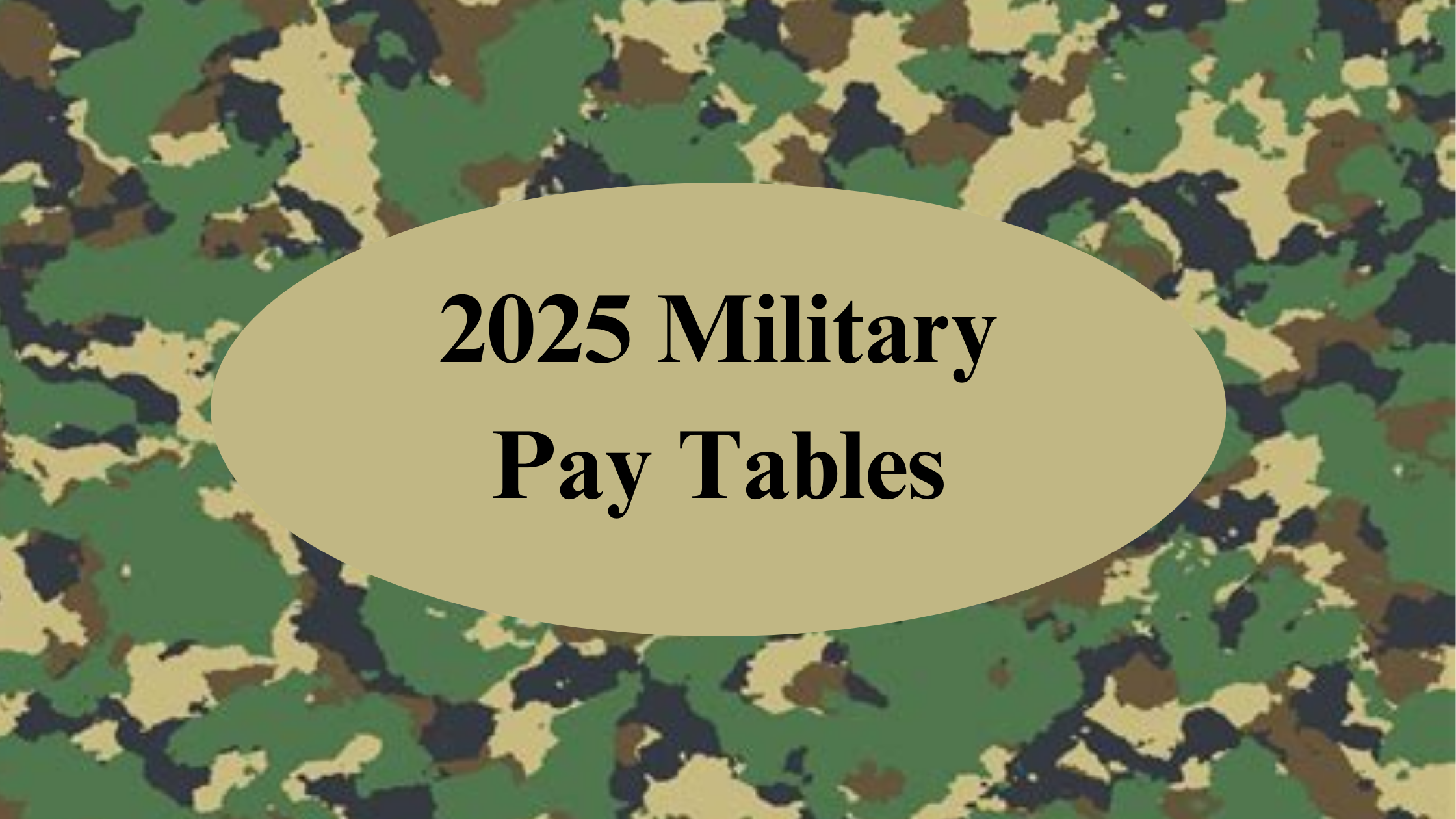The 2025 military pay grades, including projected raises for the Army, Navy, Air Force, Marine Corps, and Coast Guard. Understand pay charts, allowances, and ranks.
Understanding 2025 Military Pay Charts: A Comprehensive Guide to US Military Pay Grades
The 2025 military pay charts show the compensation structure for service members across the various branches of the U.S. armed forces, including the Army, Navy, Air Force, the Marine Corps, Space Force, and Coast Guard. These pay charts are instrumental in determining the base pay, allowances, and bonuses that military personnel receive, which are crucial for meeting their basic needs and supporting their families.
The 2025 Military Pay Tables for Active Duty Pay
What is the Basic Pay for Enlisted Personnel in 2025?
The basic pay for enlisted personnel in 2025 is structured according to their rank and years of service. For instance, an E-1 is the entry-level rank for enlisted members and they receive a base pay that increases with each year of service. As enlisted personnel advance in rank, such as reaching E-6 or E-9, their basic pay increases correspondingly. This structured pay schedule ensures that service members are rewarded for their experience and commitment to the military. The pay charts provide a clear outline of the base pay for each rank, allowing enlisted personnel to plan their financial future effectively.
Here are the military active duty enlisted basic pay chart for 2025, assuming the expected 4.5% pay raise for servicemembers is enacted by a executive order. The charts show the years in service and the corresponding pay grade.
For more details about commissioned and warrant officer pay rates, see 2025 Military Pay Table for Officers and Warrant Officers: Basic Pay Chart.
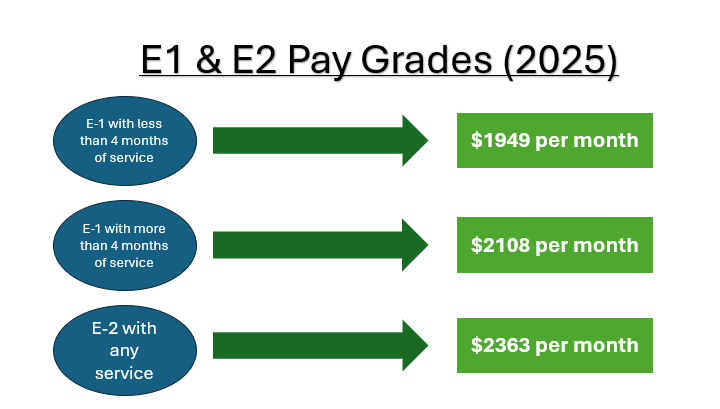
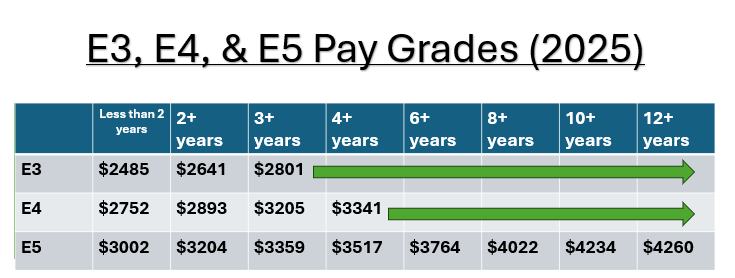
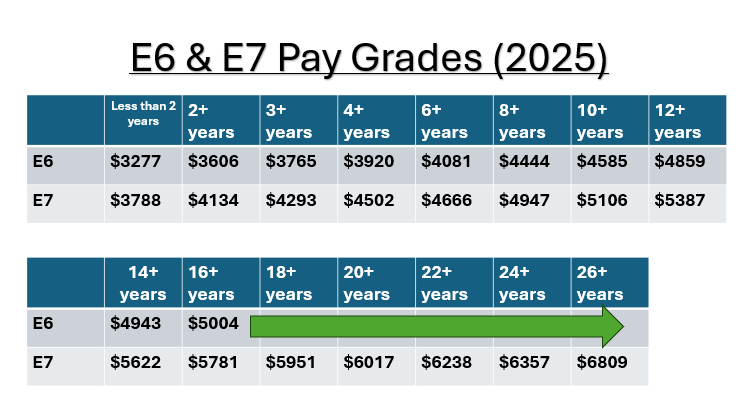
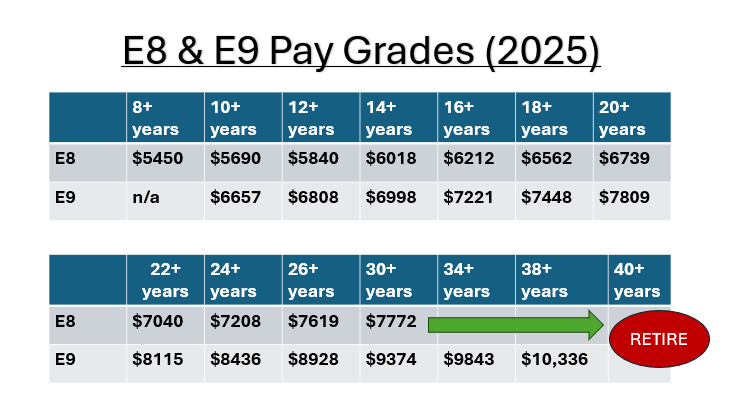
Note that there is a different pay table for US military officers.
The 2025 Pay Raise for US Military Personnel
The 2025 pay charts reflect a 4.5% percentage increase over the 2024 pay rates, providing a boost to the base pay and allowances for all ranks and grades for active enlisted employees of the DoD.
Stay up-to-date with civilian and military federal benefits: Subscribe to Our Federal Retirement Newsletter
2025 Pay Changes for Active Duty and Reserve Personnel
Reserve personnel are affected differently by pay adjustments, as their compensation structure varies from that of active duty members. While reserve personnel receive a base pay similar to their active duty counterparts, their pay is calculated based on the number of days they serve each month.
Allowances for Housing, Food, and Dependents
Additional Allowances that can Boost Military Pay
Additional allowances and bonuses can significantly enhance a service member’s paycheck, providing financial support for specific needs and circumstances. Allowances such as the Basic Allowance for Housing (BAH) and the Basic Allowance for Subsistence (BAS) are designed to cover living expenses, reducing the financial burden on service members. Bonuses, on the other hand, reward service members for their expertise, deployments, and other special duties. These additional forms of compensation are crucial for ensuring that military personnel can maintain a stable and secure financial situation, even in challenging circumstances.
US servicemembers should develop a comprehensive budget that accounts for all sources of income, including base pay, allowances, and bonuses. By prioritizing essential expenses and setting aside funds for savings and investments, service members can ensure financial stability and preparedness for future needs.
BAH, BAS, and Other Allowances
The Basic Allowance for Housing (BAH) and other allowances play a vital role in military pay, as they directly address the cost of living for service members and their families. BAH is determined based on the service member’s location, rank, and dependency status, ensuring that they can afford suitable housing in their area. Other allowances, such as the Basic Allowance for Subsistence (BAS), provide additional financial support for food and other essential needs. These allowances are critical components of the overall compensation package, allowing service members to focus on their duties.
The Basic Needs Allowance for Military Members with Dependents
The Basic Needs Allowance aims to provide additional financial support to personnel with dependents, ensuring they can meet their basic living expenses. There are income limitations on eligibility, however, and dependents must be registered. This benefit is available to all branches of the United States military, including the Coast Guard and the Reserves.
Knowledge is Confidence!
Pay Table Structure for US Military Officers
Officer Pay vs. Enlisted Pay
Department of Defense officers have a different salary structure than those receiving enlisted pay in several ways, primarily due to the additional responsibilities and leadership roles that officers undertake. Commissioned officers, starting at the O-1 pay grade, receive a higher base pay compared to enlisted personnel. This reflects the advanced training, specialty education, and leadership skills required for officer roles. As officers progress through the ranks, such as reaching O-4 or higher, their pay increases significantly. Additionally, officers may receive special pay and allowances related to their specific duties and assignments, further distinguishing their compensation from that of enlisted personnel.
Pay Grades for Warrant Officers and Commissioned Officers
Warrant officers and commissioned officers have distinct pay grades that reflect their specialized roles within the military hierarchy. Warrant officers, such as Chief Warrant Officers, are technical experts who bridge the gap between enlisted personnel and commissioned officers. Their pay grades, ranging from W-1 to W-5, are structured to reward their expertise and years of service. Commissioned officers, on the other hand, have pay grades starting from O-1 and progressing to higher ranks based on their leadership roles and responsibilities. The pay charts clearly delineate the base pay for each of these grades, ensuring transparency and consistency in military compensation.
How to Maximize Military Pay and Benefits
Strategies to Optimize Your Military TSP Account
Military personnel can maximize their military pay and benefits by strategically optimizing their contributions to the Thrift Savings Plan (TSP). The TSP is a valuable retirement savings tool that allows enlisted soldiers and officers to invest a portion of their pay for future financial security. By contributing regularly and taking advantage of any matching contributions offered by the military under the Blended Retirement System, service members can build a substantial retirement fund. Additionally, understanding the investment options within the TSP and adjusting contributions based on individual financial goals and risk tolerance can enhance the potential for long-term growth and financial stability.
Start planning your retirement today. Estimate your TSP balance with our Thrift Savings Plan Calculator.
Financial Planning for US Military Members
Several factors should be considered when planning for pay changes, including the impact on one’s overall financial situation and long-term goals. Changes in allowances and bonuses should be factored in to explore opportunities for optimizing your financial plan. Additionally, staying informed about potential future changes in military pay and benefits can help maintain financial stability and achieving long-term financial goals.
Reach Out to Us!
If you have additional federal benefit questions, contact our team of CERTIFIED FINANCIAL PLANNER™ (CFP®), Chartered Federal Employee Benefits Consultants (ChFEBC℠), and Accredited Investment Fiduciaries (AIF®). At PlanWell, we are federal employee financial advisors with a focus on retirement planning. Learn more about our process designed for the career fed.
Preparing for federal retirement? Check out our scheduled federal retirement workshops. Sign up for our no-cost federal retirement webinars through our online workshop. Make sure to plan ahead and reserve your seat for our FERS webinar, held every three weeks. Want to have PlanWell host a federal retirement seminar for your agency? Reach out, and we’ll collaborate with HR to arrange an on-site FERS seminar.
Want to fast-track your federal retirement plan? Skip the FERS webinar and start a one-on-one conversation with a ChFEBC today. You can schedule a one-on-one meeting on our Contact page.


